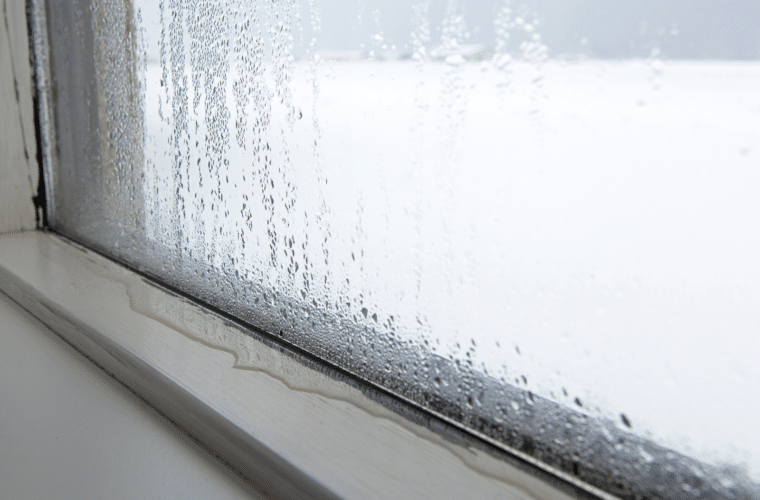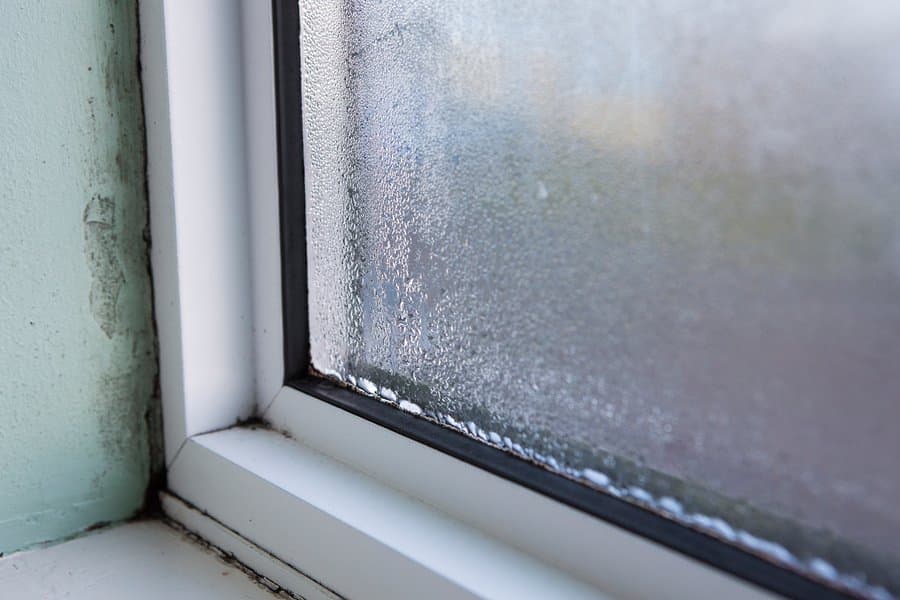Sections in this Article:
- Is Condensation Caused by the Windows?
- When Does Condensation Most Often Occur?
- When is Condensation a Sign of Something More Serious?
- Prevention Methods
- How New Windows Prevent Condensation
Throughout the year, window condensation – or window sweating – is a natural occurrence on the windows of your home or office, and it can happen frequently on new replacement windows. When we see condensation, our first thought is that there’s something wrong.
In most cases, condensation is not a sign of a faulty window.
It may be a sign of an energy-efficient window. New, more energy-efficient and better-insulated windows tend to gather a bit of condensation. Therefore, interior glass temperatures are higher during cold weather than outdoor air. When cool outdoor air reaches this warmer interior glass, the temperature differential is more significant, and condensation is more likely to form.
In the summer, the opposite happens. Better insulation keeps cold temperatures inside, and the interior glass tends to be colder. When this cold air meets the warm outdoor air, condensation is more likely to form on the exterior of the window.
The bottom line is that window condensation can be a pesky problem; in most cases, it’s not a cause for alarm. However, there are some instances in which indoor humidity or issues with the window may be causing condensation. We’ve highlighted a few common causes of window condensation and things you can do to fix them here.
Is Condensation Caused by the Window?
The short answer is no. Condensation shouldn’t alarm you; your windows are not faulty. A small condensation during the coldest and hottest months may be a good sign. It means that your windows effectively hold warm air (in winter) or fresh air (in summer) inside.
Today’s replacement windows are extremely energy efficient. They’re designed to conserve energy inside your property, so the temperature difference from outside to inside is greater. That’s why you might notice some condensation if you’ve recently replaced your windows.
In other words, you might have never noticed condensation during winter, because your old windows weren’t correctly keeping the warm air inside. They were drafty, and the warm, moist interior air was escaping out the window, causing the air around the window to be a consistent temperature and the moisture from inside to escape rather than collecting on the window.

When Does Condensation Most Often Occur?
Condensation commonly occurs in northern U.S. climates, in the Mid-West and further south, during cold snaps and heat waves. It is most likely to form when interior and exterior temperatures are extreme, i.e., during a Polar Vortex or the hottest, most humid summer days.
Condensation usually forms on the interior of the window pane in the winter. During summer months, it develops on the exterior of the window, similar to morning dew. In summer, though, condensation often burns off as the day progresses.
When the humidity inside your property is high, there is more moisture in the air, and condensation occurs more frequently. That’s why condensation commonly collects on windows after a shower, when doing the dishes, or when running a humidifier. This happens because there’s a lot more moisture in the air, and it can’t escape at the window. As a result, condensation forms on the glass.
At the beginning of the heating season, condensation is also very common because the heating system brings more moisture into the air. The building absorbs this moisture as the season advances, decreasing condensation incidence.
In short, window condensation shouldn’t cause alarm, especially temporarily. Here are some of the most common reasons for window condensation:
- Early in the heating season, as new moisture is circulated in the property
- Sharp drops or gains in temperature, as temperature differentials are greatest
- When the difference in temperature from outside to inside is at its most extreme
- When steam is produced inside, e.g., during cooking, when doing laundry, or when showering
- During remodeling or new construction, the moisture from the building materials is released into the air, which increases the humidity of the air
When Is Condensation a Sign of Something More Serious?
Excessive condensation can be annoying and, in some cases, a sign of something more serious. First, it may indicate that it is excessive “problem” moisture in the air. If you notice water spots on the ceiling or walls, your heating or cooling system may put too much moisture in the air, or you may have water leaking somewhere in the property. The result is a higher humidity level, which causes condensation to form more frequently. To remedy this, you need to find the cause of the humidity at the source.
Condensation rarely indicates a defective window; however, if water is accumulating between the panes of glass, it usually means the seal is compromised. When this happens, replacing the window or repairing the seal is necessary.
A few other signs that condensation may be a bigger problem include:
- Condensation stays on the window for long periods
- Excessive condensation that runs down walls or causes discoloration
- Excessive moisture inside, mold, mildew, and rot are also signs of problem moisture
- Condensation forms between two panes of glass, which could indicate a faulty seal
Preventing Window Condensation
So, what can you do? Ultimately, the best solution depends on the severity of the problem and its cause. Controlling moisture is the fastest and surest fix if you’re experiencing condensation because of high indoor humidity levels. To stop condensation on poorly insulated windows, improve the weather sealing or consider window replacement as the best fix.
A few quick fixes for window condensation include:
• Controlling Interior Humidity: If too much moisture is in the air, condensation is more likely to form on windows. The remedy may be as simple as moving plants and fish tanks away from windows. The source of the humidity may be something more serious, like a faulty cooling system. We recommend first identifying the source of the moisture. Updating a newer HVAC system, using a dehumidifier, or upgrading a ventilation system can all help to reduce moisture and window condensation.
• Increasing Ventilation: Better air circulation improves the airflow along the window, which may help reduce condensation. For instance, running an exhaust fan when using the shower is a conventional method for circulating warm, wet air in the home. Additionally, ceiling fans, opening windows, and/or installing a heat recovery ventilator can also increase airflow and reduce condensation. Sometimes, all you need is just a bit more air movement to keep the temperatures constant and reduce moisture in the air.
• Opening Drapes/Blinds: Heavy drapes minimize the flow of air at the window, which can contribute to condensation. By opening drapes and window treatments, the air moves more freely along the window, effectively reducing condensation.
Will New Windows Reduce Condensation?
If your property has inefficient, single-pane windows, condensation can be a constant battle during winter and the high heat of summer. The reason is that the windows are poorly insulated. Therefore, the temperature of the glass from outside to inside tends to be extreme, and condensation is created as a result.
Today’s double- or triple-paned replacement windows, though, have some features that can help to reduce condensation drastically. These features include:
- Double or Triple Glazing—Updating single-pane windows with double—or triple-paned windows can quickly minimize condensation. The spacing between the exterior-facing and interior-facing glass dramatically reduces the temperature differential, making condensation less likely to form.
- Gas Fills – Many of today’s double-paned windows have gas fills between the layers of glazing. This helps to slow heat transfer, and in winter, the warm interior glass doesn’t come into direct contact with the cold outdoor air.
- Coatings and Films—Energy-efficient window coatings add a layer of insulation to the glass, creating a barrier between the glazing and humid indoor air. This can prevent interior moisture from collecting on the glass.
- Efficient Spacers – In double- or triple-paned windows, spacers sit between each glass pane. Today’s spacers are more efficient than ever and utilize materials like metal alloy or foam to reduce heat transfer and seal out moisture. Foam tends to be one of the most efficient options for creating a warm edge around the window.
- Weatherstripping – Poor insulation around the edges of the window allows air to escape, and as a result, the temperature of the glass drops, e.g., warmer in winter and colder in summer.
As a result, this airflow can be a significant source of condensation. Built-in sealants and weather-stripping in new windows actively create a seal that is tight against air and moisture.
In short, window condensation or sweating shouldn’t cause alarm, especially if you’ve recently installed new windows. If condensation lingers on windows, this often indicates that the interior glass is warmer due to the windows’ improved insulation, suggesting that you may have more significant moisture issues.
Contact Aeroseal
Interested in how new windows can help reduce condensation? Contact Aeroseal today for more information about our energy-efficient replacement windows. Our commercial windows are designed and built with the latest features to minimize condensation. If you have any concerns about your window or suspect it may be faulty, be sure to give us a call at 1-888-380-2376.

